Jefferson City | |
|---|---|
 | |
| Nickname(s): Jeff City, JC, JCMO [1] | |
| Motto: Jefferson City | |
 | |
 U.S. Census Map | |
| Coordinates: 38°34′04″N 92°10′33″W / 38.56778°N 92.17583°W | |
| Country | |
| State | |
| Counties | |
| Founded | 1821 |
| Incorporated | 1825 |
| Named for | Thomas Jefferson |
| Government | |
| • Type | Mayor–council |
| • Mayor | Ron Fitzwater |
| • Administrator | Brian Crane |
| Area | |
| • State capital | 37.65 sq mi (97.51 km2) |
| • Land | 36.05 sq mi (93.38 km2) |
| • Water | 1.60 sq mi (4.13 km2) |
| Elevation | 630 ft (192 m) |
| Population (2020) | |
| • State capital | 43,228 |
| • Density | 1,198.98/sq mi (462.93/km2) |
| • Metro | 149,807 |
| Time zone | UTC−6 (CST) |
| • Summer (DST) | UTC−5 (CDT) |
| ZIP codes | 65101-65111 |
| Area code | 573 |
| FIPS code | 29-37000[6] |
| GNIS ID | 758233[5] |
| U.S. Routes | |
| State highways | |
| Waterways | Missouri River |
| Public transit | JeffTran |
| Website | jeffersoncitymo.gov |
Jefferson City, informally Jeff City,[1] is the capital of the U.S. state of Missouri. It had a population of 43,228 at the 2020 census,[7] ranking as the 15th most populous city in the state.[8] It is also the county seat of Cole County and the principal city of the Jefferson City Metropolitan Statistical Area, the second-most-populous metropolitan area in Mid-Missouri and the fifth-largest in the state. Most of the city is in Cole County, with a small northern section extending into Callaway County. Jefferson City is named for Thomas Jefferson, the third President of the United States.
Jefferson City is located on the northern edge of the Ozark Plateau on the southern side of the Missouri River in a region known as Mid-Missouri, that is roughly mid-way between the state's two large urban areas of Kansas City and St. Louis. It is 29 miles (47 km) south of Columbia, Missouri, and sits at the western edge of the Missouri Rhineland, one of the major wine-producing regions of the Midwest. The city is dominated by the domed Capitol, which rises from a bluff overlooking the Missouri River to the north; Lewis and Clark passed the bluff on their historic expedition upriver before Europeans established any settlement there.
Many of Jefferson City's primary employers are in service and manufacturing industries. Jefferson City is also home to Lincoln University, a public historically black land-grant university founded in 1866 by the 62nd Regiment of U.S. Colored Troops with support from the 65th Regiment of U.S. Colored Troops.
|
Further information: Missouri State Capitol Historic District |
|
See also: Missouri State Penitentiary and 1870 Missouri State Colored People's Educational Convention |
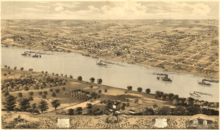
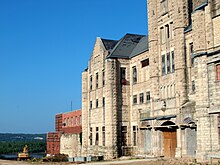
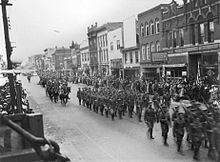
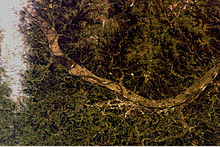
In pre-Columbian times, this region was home of an ancient people known only as the "Mound Builders", being replaced by Osage Native Americans. In the late 17th century, frontiersmen started to inhabit the area, including Antoine de la Mothe Cadillac, Louis Jolliet, Jacques Marquette, Robert de LaSalle, and Daniel Boone, with the latter having the greatest influence on the region. Daniel Boone's son, Daniel Morgan Boone, would later lay out Jefferson City in the early 19th century.
When the Missouri Territory was organized in 1812, St. Louis was Missouri's seat of government, and St. Charles would serve as the next capital. However, Jefferson City was chosen as the new capital in 1821. The village first was called "Lohman's Landing", and when the legislature decided to relocate there, they proposed the name "Missouriopolis" before settling on the city of "Jefferson" to honor Thomas Jefferson.[10][11] Over the years, the city was most often referred to as "Jefferson City" and the name stuck. For years, this village was little more than a trading post located in the wilderness about midway between St. Louis and Kansas City. In 1825, the settlement was incorporated as a city and a year later, the Missouri legislature first met in Jefferson City.
Jefferson City was chosen as the site of a state prison. This prison, named the Missouri State Penitentiary, opened in 1836. This prison was home to multiple infamous Americans, including former heavyweight champion Sonny Liston, assassin James Earl Ray, and bank robber Pretty Boy Floyd.
During the Civil War, Jefferson City was occupied by Union troops and the elected state legislature was driven from Jefferson City by Union General Nathaniel Lyon. Some of the legislators later reconvened in Neosho and passed an ordinance of secession. Missouri was claimed by both the Confederacy and the Union, as was neighboring state Kentucky. Missourians were strongly divided and many people in the state—especially in St. Louis—supported the Union, while other areas (such as Missouri's Little Dixie) were strongly pro-Confederate along the Missouri River between Jefferson City and Kansas City.
German immigrants created vineyards in small towns on either side of the Missouri River, especially on the north from the city east to Marthasville, located outside of St. Louis. Known as the "Missouri Rhineland" for its vineyards and first established by German immigrants in the mid-1800s, this region has become part of Missouri's agricultural and tourist economy.
|
See also: Tornado outbreak of May 2019 |
Approximately 15 minutes before midnight on May 22, 2019, a tornado emergency was issued for the Jefferson City area. Minutes later, a destructive EF-3[12] tornado caused extensive damage on the southwest side of the city.[13][14] At least 20 people were injured, but none was killed due to this tornado.[15]
According to the United States Census Bureau, the city has a total area of 37.58 square miles (97.33 km2), of which 35.95 square miles (93.11 km2) is land and 1.63 square miles (4.22 km2) is water.[16]
Jefferson City has a humid continental climate (Dfa) with hot, rainy summers and cold winters. The city borders on having a humid subtropical climate but falls just short due to January having a mean temperature of 30 °F (−1 °C) which is below the 32 °F (0 °C) isotherm. Thunderstorms are common in both the spring and summer. Light snow is common during the winter, although about half of wintertime precipitation falls as rain.[17]
| Climate data for Jefferson City WTP, Missouri (1991–2020 normals, extremes 1894–present) | |||||||||||||
|---|---|---|---|---|---|---|---|---|---|---|---|---|---|
| Month | Jan | Feb | Mar | Apr | May | Jun | Jul | Aug | Sep | Oct | Nov | Dec | Year |
| Record high °F (°C) | 79 (26) |
89 (32) |
97 (36) |
96 (36) |
102 (39) |
107 (42) |
114 (46) |
111 (44) |
107 (42) |
96 (36) |
88 (31) |
79 (26) |
114 (46) |
| Mean daily maximum °F (°C) | 39.6 (4.2) |
45.1 (7.3) |
55.5 (13.1) |
66.6 (19.2) |
75.2 (24.0) |
83.9 (28.8) |
88.0 (31.1) |
87.2 (30.7) |
79.9 (26.6) |
68.5 (20.3) |
55.1 (12.8) |
44.0 (6.7) |
65.7 (18.7) |
| Daily mean °F (°C) | 30.3 (−0.9) |
34.9 (1.6) |
44.6 (7.0) |
55.2 (12.9) |
64.9 (18.3) |
74.1 (23.4) |
78.3 (25.7) |
76.9 (24.9) |
69.0 (20.6) |
57.2 (14.0) |
45.0 (7.2) |
34.9 (1.6) |
55.4 (13.0) |
| Mean daily minimum °F (°C) | 21.0 (−6.1) |
24.7 (−4.1) |
33.7 (0.9) |
43.8 (6.6) |
54.6 (12.6) |
64.3 (17.9) |
68.6 (20.3) |
66.6 (19.2) |
58.1 (14.5) |
45.8 (7.7) |
34.8 (1.6) |
25.7 (−3.5) |
45.1 (7.3) |
| Record low °F (°C) | −23 (−31) |
−25 (−32) |
−16 (−27) |
13 (−11) |
24 (−4) |
38 (3) |
42 (6) |
41 (5) |
29 (−2) |
14 (−10) |
1 (−17) |
−24 (−31) |
−25 (−32) |
| Average precipitation inches (mm) | 2.21 (56) |
2.30 (58) |
3.24 (82) |
4.78 (121) |
5.17 (131) |
4.20 (107) |
4.35 (110) |
4.13 (105) |
4.24 (108) |
3.44 (87) |
3.24 (82) |
2.30 (58) |
43.60 (1,107) |
| Average snowfall inches (cm) | 2.9 (7.4) |
2.9 (7.4) |
0.4 (1.0) |
0.0 (0.0) |
0.0 (0.0) |
0.0 (0.0) |
0.0 (0.0) |
0.0 (0.0) |
0.0 (0.0) |
0.0 (0.0) |
0.2 (0.51) |
2.5 (6.4) |
8.9 (23) |
| Average precipitation days (≥ 0.01 in) | 7.9 | 7.5 | 11.0 | 11.5 | 12.2 | 9.7 | 8.5 | 8.1 | 7.8 | 9.4 | 8.5 | 8.1 | 110.2 |
| Average snowy days (≥ 0.1 in) | 1.9 | 1.1 | 0.4 | 0.0 | 0.0 | 0.0 | 0.0 | 0.0 | 0.0 | 0.0 | 0.3 | 1.4 | 5.1 |
| Source: NOAA[18][19] | |||||||||||||
| Census | Pop. | Note | %± |
|---|---|---|---|
| 1860 | 3,082 | — | |
| 1870 | 4,420 | 43.4% | |
| 1880 | 5,271 | 19.3% | |
| 1890 | 6,742 | 27.9% | |
| 1900 | 9,664 | 43.3% | |
| 1910 | 11,850 | 22.6% | |
| 1920 | 14,490 | 22.3% | |
| 1930 | 21,596 | 49.0% | |
| 1940 | 24,268 | 12.4% | |
| 1950 | 25,099 | 3.4% | |
| 1960 | 28,228 | 12.5% | |
| 1970 | 32,407 | 14.8% | |
| 1980 | 33,619 | 3.7% | |
| 1990 | 35,481 | 5.5% | |
| 2000 | 39,636 | 11.7% | |
| 2010 | 43,079 | 8.7% | |
| 2020 | 43,228 | 0.3% | |
| U.S. Decennial Census | |||
The 2020 United States census[20] counted 43,228 people, 16,882 households, and 9,327 families in Jefferson City. The population density was 1,199.1 per square mile (463.0/km2). There were 18,942 housing units at an average density of 525.4 units per square mile (202.9 units/km2). The racial makeup was 74.33% (32,130) white, 15.83% (6,841) black or African-American, 0.3% (131) Native American, 1.82% (786) Asian, 0.1% (43) Pacific Islander, 1.31% (566) from other races, and 6.32% (2,731) from two or more races. Hispanic or Latino of any race was 3.6% (1,523) of the population.
Of the 16,882 households, 25.7% had children under the age of 18; 40.2% were married couples living together; 34.4% had a female householder with no husband present. Of all households, 39.6% consisted of individuals and 15.8% had someone living alone who was 65 years of age or older. The average household size was 2.2 and the average family size was 3.0.
20.0% of the population was under the age of 18, 10.0% from 18 to 24, 28.3% from 25 to 44, 25.0% from 45 to 64, and 15.3% who were 65 years of age or older. The median age was 38.0 years. For every 100 females, the population had 106.2 males. For every 100 females ages 18 and older, there were 110.9 males.
The 2016-2020 5-year American Community Survey[21] estimates show that the median household income was $54,003 (with a margin of error of +/- $2,176) and the median family income was $75,490 (+/- $7,940). Males had a median income of $35,561 (+/- $4,299) versus $31,226 (+/- $1,953) for females. The median income for those above 16 years old was $32,642 (+/- $2,031). Approximately, 8.8% of families and 11.9% of the population were below the poverty line, including 17.8% of those under the age of 18 and 6.9% of those ages 65 or over.
At the 2010 census, there were 43,079 people in 17,278 households, including 9,969 families, in the city. The population density was 1,198.3 inhabitants per square mile (462.7/km2). There were 18,852 housing units at an average density of 524.4 units per square mile (202.5 units/km2). The racial makeup of the city was 78.0% White, 16.9% African American, 0.3% Native American, 1.8% Asian, 0.1% Pacific Islander, 0.8% from other races, and 2.2% from two or more races. Hispanic or Latino people of any race were 2.6%.[6]
Of the 17,278 households 28.8% had children under the age of 18 living with them, 41.6% were married couples living together, 12.4% had a female householder with no husband present, 3.7% had a male householder with no wife present, and 42.3% were non-families. 36.2% of households were one person and 11.5% were one person aged 65 or older. The average household size was 2.21 and the average family size was 2.89.
The age distribution was 20.9% of residents under the age of 18, 10.3% between the ages of 18 and 24, 28.6% from 25 to 44, 26.8% from 45 to 64, and 13.4% 65 or older. The median age was 37.5 years. The gender makeup of the city was 51.2% male and 48.8% female.
At the 2000 census, there were 39,636 people in 15,794 households, including 9,207 families, in the city. The population density was 1,454.4 inhabitants per square mile (561.5/km2). There were 16,987 housing units at an average density of 623.3 units per square mile (240.7 units/km2). The racial makeup of the city was 81.5% White, 14.7% Black or African American, 0.4% Native American, 1.2% Asian, 0.1% Pacific Islander, 0.6% from other races, and 1.5% from two or more races. 1.6% of the population were Hispanic or Latino of any race.[6] Of the 15,794 households 27.9% had children under the age of 18 living with them, 44.4% were married couples living together, 10.8% had a female householder with no husband present, and 41.7% were non-families. 36.1% of households were one person and 11.9% were one person aged 65 or older. The average household size was 2.21 and the average family size was 2.90.
The age distribution was 20.9% under the age of 18, 11.0% from 18 to 24, 32.1% from 25 to 44, 22.0% from 45 to 64, and 14.0% 65 or older. The median age was 36 years. For every 100 females, there were 105.3 males. For every 100 females age 18 and over, there were 106.6 males.
The median household income was $39,628 and the median family income was $52,627. Males had a median income of $35,050 versus $25,521 for females. The per capita income for the city was $21,268. About 7.3% of families and 11.5% of the population were below the poverty line, including 17.1% of those under age 18 and 7.1% of those age 65 or over.
| Jefferson City's top employers (2016)[22] | ||
|---|---|---|
| Rank | Employers | # of employees |
| 1 | State of Missouri | 14,223 |
| 2 | Capital Region Medical Center | 1,573 |
| 3 | Scholastic | 1,500 |
| 4 | Jefferson City Public Schools | 1,489 |
| 5 | SSM Health-St. Mary's Hospital | 1,154 |
| 6 | Central Bancompany | 967 |
| 7 | ABB Power T&D Company | 775 |
| 8 | Jefferson City Medical Group | 633 |
| 9 | Wal-Mart Supercenter | 622 |
| 10 | Unilever | 510 |
| No change reported in 2017 | ||
Jefferson City's economy is driven by its residents, citizens of surrounding communities, and tourists.
Jefferson City's economy relies on government, health care, manufacturing, retail, education, and tourism. In 2016, Jefferson City's gross metropolitan product was $7.366 billion[23] and Missouri's real total gross domestic product was $260.309 billion,[24] making Jefferson City's economy 2.829% of the total gross state product of Missouri.
Central Bancompany, Hawthorn Bancshares, Capital Region Medical Center, and Arris Pizza all have their headquarters in Jefferson City. Jefferson City is also home to Central Dairy, whose products are shipped statewide.
Tourists are drawn to the Missouri State Capitol, St. Peter Church (adjacent to the capitol), Missouri State Penitentiary, Missouri Governor's Mansion, and Missouri State Museum. Lincoln University, ranked by U.S. News & World Report in 2007 as a top educational institution for international students, also helps draw students and tourists from other states and countries.

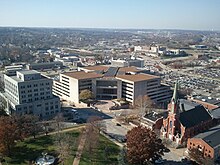

The State Capitol is located in Jefferson City. In addition, state agencies are headquartered in Jefferson City. The Missouri State Archives is located in Jefferson City.
The Missouri Department of Corrections (MDOC) operates the Jefferson City Correctional Center (JCCC) and the Algoa Correctional Center (ACC) in Jefferson City.[25][26] JCCC replaced the Missouri State Penitentiary on September 15, 2004, which until its closure was the oldest operating penal facility west of the Mississippi River. It served as the State of Missouri's primary maximum security institution,[27] and it housed male death row prisoners until April 1989, when they were moved to the Potosi Correctional Center.[27]
The United States Postal Service operates several postal facilities. The Jefferson City Main Post Office building[28] previously shared occupancy with the U.S. District Court from its dedication in November 1934 until September 27, 2011, when it moved into the Christopher S. Bond Court House.
The 118,000-square-foot courthouse is named for the former Governor and United States Senator from Missouri. The courthouse, which is occupied by the Central Division of the United States District Court for the Western District of Missouri and under the appellate jurisdiction of the United States Court of Appeals for the Eighth Circuit, was designed to achieve the U.S. Green Building Council's LEED Gold rating. Sustainable design features include reducing water use by 44 percent, using 13 percent recycled content, diverting 80 percent of construction waste materials from landfills, and it is 36 percent more efficient than current energy standards.[29]
Jefferson City Public School District currently operates Jefferson City High School and Capital City High School, two middle schools, Thomas Jefferson Middle School, and Lewis and Clark Middle School, and eleven elementary schools. In addition to public education, there are also five private elementary schools and three private high schools, including Helias High School and Calvary Lutheran High School in the city.
Lincoln University is a public historically black university with open enrollment and certificate, associate, bachelor, and graduate programs.
Columbia College, William Woods University, Metro Business College, and Merrell University also have campuses in the city with varying degree levels and options.
The University of Missouri, the state's flagship university, is 30 miles to the north in Columbia.
Jefferson City has a public library, the Missouri River Regional Library.[30]
The major daily English-language newspaper in the area is the Jefferson City News Tribune. Several monthly magazines cover Jefferson City and/or the surrounding areas: Jefferson City Magazine, Her Magazine, Capital Lifestyles, and Professional Day.
Jefferson City, along with Columbia, is part of the Mid-Missouri television market. KRCG, the region's CBS affiliate, and KFDR, a station owned by the Christian Television Network (CTN), are both licensed to the city.
The following is a list of radio stations that broadcast from and/or are licensed to Jefferson City, Missouri.
| Frequency | Callsign | Nickname | Format | Owner | City of License | Web site |
|---|---|---|---|---|---|---|
| 88.1 | KHJR | Covenant Network | Catholic | Covenant Network | St. Thomas, MO | [1] |
| 88.9 | KJLU | 88.9 KJLU | Jazz | Lincoln University of Missouri | Jefferson City, MO | [2] |
| 89.9 | KMCV | Religion | Bott Radio | High Point, MO | [3] | |
| 90.3 | KNLG | Here's Help Network | Religion | New Life Evangelistic Center | New Bloomfield, MO | [4] Archived April 14, 2022, at the Wayback Machine |
| 94.3 | KATI | KAT Country 94.3 | Country | Zimmer Radio Group | California, MO | [5] |
| 97.1 | K246CA | Religion | Bott Radio | Jefferson City, MO | [6] | |
| 97.5 | KJMO | 97.5 KJMO | Classic Hits | Cumulus Media | Linn, MO | [7] |
| 98.7 | KOTC | 3ABN | Religion | Jefferson City Seventh-Day Adventist Church | Jefferson City, MO | [8] |
| 100.1 | KBBM | 100.1 NASH FM | Country | Cumulus Media | Jefferson City, MO | [9] |
| 103.5 | K278CT | News Talk 1240 | News/Talk | Cumulus Media | Jefferson City, MO | [10] |
| 104.5 | K283CL | NewsRadio KWOS | News/Talk | Zimmer Radio Group | Jefferson City, MO | [11] |
| 104.9 | K283CL | Elevate FM | Contemporary Worship Music | Lake Area Educational Broadcasting Foundation | Jefferson City, MO | [12] |
| 106.5 | K293AX | Spirit FM | Christian Contemporary | Lake Area Educational Broadcasting Foundation | Jefferson City, MO | [13] |
| 106.9 | KTXY | Y107 | Mainstream Top 40 | Zimmer Radio Group | Jefferson City, MO | [14] |
| 950 | KWOS | NewsRadio KWOS | News/Talk | Zimmer Radio Group | Jefferson City, MO | [15] |
| 1240 | KLIK | News Talk 1240 | News/Talk | Cumulus Media | Jefferson City, MO | [16] |
Federal highways are U.S. Routes 50, 54, and 63. Missouri Routes 179 and 94 also run through the city. Jefferson City is one of the four state capitals that is not served by an Interstate highway (the others are Dover, Delaware; Juneau, Alaska; and Pierre, South Dakota).[31] However, Interstate 70 passes by the city 30 miles (48 km) to the north in Columbia.
The city is served by Columbia Regional Airport and nearby Jefferson City Memorial Airport.[32][33]
JeffTran, the city operated public transit system, provides year-round bus service during traditional weekday business hours,[34] but is currently considering the extension of service hours to include evenings and weekends.[35]
The Jefferson City station, located in the former Union Hotel at Jefferson Landing State Historic Site, is one of the Missouri River Runner train stops between Kansas City and St. Louis, provided by Amtrak, the sole intercity passenger railroad service in the United States.
A Greyhound bus stop near the Eastland Drive Convenient Food Mart[36] also provides intercity transit. Jefferson City Memorial Airport, which is located in the Jefferson City limits of Callaway County, Missouri, serves general aviation but has no scheduled commercial airline service.
Jefferson City is home to SSM Health St. Mary's Hospital, which has 154 beds. Capital Region Medical Center, an affiliate of University of Missouri Health Care, is also located in the city.
|
Main article: List of people from Jefferson City, Missouri |
Jefferson City is the sister city to the German city of Münchberg.[37] Around 200 years ago, settlers from Münchberg founded a neighborhood south of downtown Jefferson City, which is still known as "Old Munichburg".